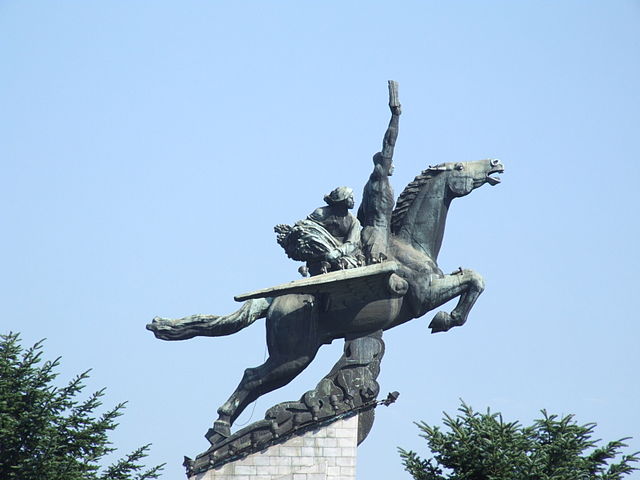From the Paleolithic paintings of the Chauvet Cave to Tolkien’s Shadowfax, horses have played a central role in mankind’s legends, cultures, and myths. Used as beasts of burden on farms, weapons on the battlefield, and as simple companions, perhaps no other domesticated animal has been so vital and intrinsic to the evolution of humans. Here below are ten of the most significant mythical horses in history.
10. Chollima – East Asian Mythology

Appearing in many East Asian cultures, “Chollima” literally translates to “thousand-li horse.” A “li” was a traditional Chinese unit of distance. In antiquity, a thousand “li” would equal about 400 km. Therefore, the legendary winged Chollima could travel 400 km in a single day. Chollima first originated around the 3rd century BCE alongside Bole, a mythological horse-tamer and retainer of Duke Mu of Qin. However, the Chollima has gained notoriety in the past few decades after being adopted as a symbol of progress and economic development by the North Korean government.
9. Tulpar – Ancient Turkey

“Tulpar” is the term used in Inner Asian Turkic languages to refer to winged horses. Tulpars appear in many Inner Asian legends and myths. One legend tells of how Ösküs-ool, a Tuvan folk hero, used the remains of his beloved tulpar to invent the very first fiddle. It is believed that the tulpar first originated as a symbolic combination of a horse and a bird of prey, both of which are tools used by the inhabitants of Central Asia for hunting. The tulpar is so crucial to Central Asian cultural identity that it appears in the state emblems of both Kazakhstan and Mongolia.
8. Mares of Diomedes – Ancient Greece

The four Mares of Diomedes, named Podagros, Lampon, Xanthos, and Deimos, were crazed, man-eating horses owned by the giant Diomedes. Their strange diet made them equal parts insane and ruthless in battle. As the eighth of his twelve labors, Heracles was tasked with capturing and taming them. Heracles only managed to complete this labor after feeding Diomedes to them. In addition to being figures in classical Greek mythology, it is said that Bucephalus, Alexander the Great’s horse, was a product of their lineage.
7. Kanthaka – Buddhist Mythology

Described as being “eighteen cubits in length from the nape of his neck, and of proportionate height…and white all over like a clean chank shell” according to ancient folklore (as translated in Trübner’s Oriental Series), Kanthaka was the favorite horse of Siddh?rtha Gautama, the historical Buddha, i.e. the founder of Buddhism. Kanthaka was the horse Siddh?rtha Gautama used to escape his family’s palace when he decided to become an ascetic. After dying, Kanthaka was reborn as a scholar who would later go on to achieve enlightenment.
6. Widow-Maker/Lightning – American Mythology
While not technically a mythological horse (it would be more accurate to call it a fakeloric horse), the Widow-Maker (alternately known as “Lightning”) was the horse of Pecos Bill, a legendary cowboy from the days of the American Old West. It is said that only Pecos Bill could ride him. That horse must have had quite the temperament considering the fact that his favorite food was dynamite!
5. Four Horses of the Apocalypse – Christian Mythology

Symbolizing (military) Conquest, War, Famine, and Death, the Four Horses of the Apocalypse are mentioned in the Christian Book of Revelation as being harbingers of the Last Judgment during the apocalypse. The four horses, respectively colored white, red, black, and pale/yellowish green, have been central figures in Christian eschatology for millennia. While some have interpreted them as symbols for events during the first century of Christian history, they are more widely interpreted as being prophetic in nature.
4. Al-Buraq – Islamic

According to Islamic tradition, Al-Buraq is the steed responsible for transporting prophets. The name comes from the Arabic word “bur?q,” or “lightning.” The most famous story involving Al-Buraq is found in the Quran where it carried the prophet Muhammad, accompanied by the angel Jibril (Gabriel), from Mecca to Jerusalem and then up to heaven to converse with Allah during the “Night Journey.” Though occasionally depicted as having a literal human face, Al-Bur?q is described as being white and having two wings on his thighs.
3. Uchchaihshravas – Hindu Mythology

Uchchaihshravas (now there’s a mouthful) is a white, seven-headed flying horse that serves as the mount for the Hindu god-king of heaven Indra and, in other stories, Bali, the king of demons. Uchchaihshravas was born alongside other mythical objects such as the elixir of life and Lakshmi, the goddess of fortune, from the Churning of the Ocean of Milk, an incident found in ancient Hindu texts.
2. Sleipnir – Norse Mythology

What kind of creature could serve as the steed of Odin, king of the Norse gods? Try Sleipnir, an eight-legged horse borne of Loki that was so powerful that nothing could slow him down. Sleipnir was also capable of traveling to Hel, such as one time when Hermod rode him down to that region in order to try and rescue his brother Balder. Sleipnir was considered to be the greatest of all horses, a title which, considering his master, doesn’t seem so out of place.
1. Pegasus – Ancient Greece

When people think of mythological horses, Pegasus, the white winged stallion sired by Poseidon, is one of the very first to come to mind. After helping the Greek hero Bellerophon defeat the Chimera, Zeus transformed him into a constellation and gave him a place in the sky. Pegasus is one of the most instantly recognizable mythical creatures in the West, appearing in countless paintings, poems, songs, books, and films.
